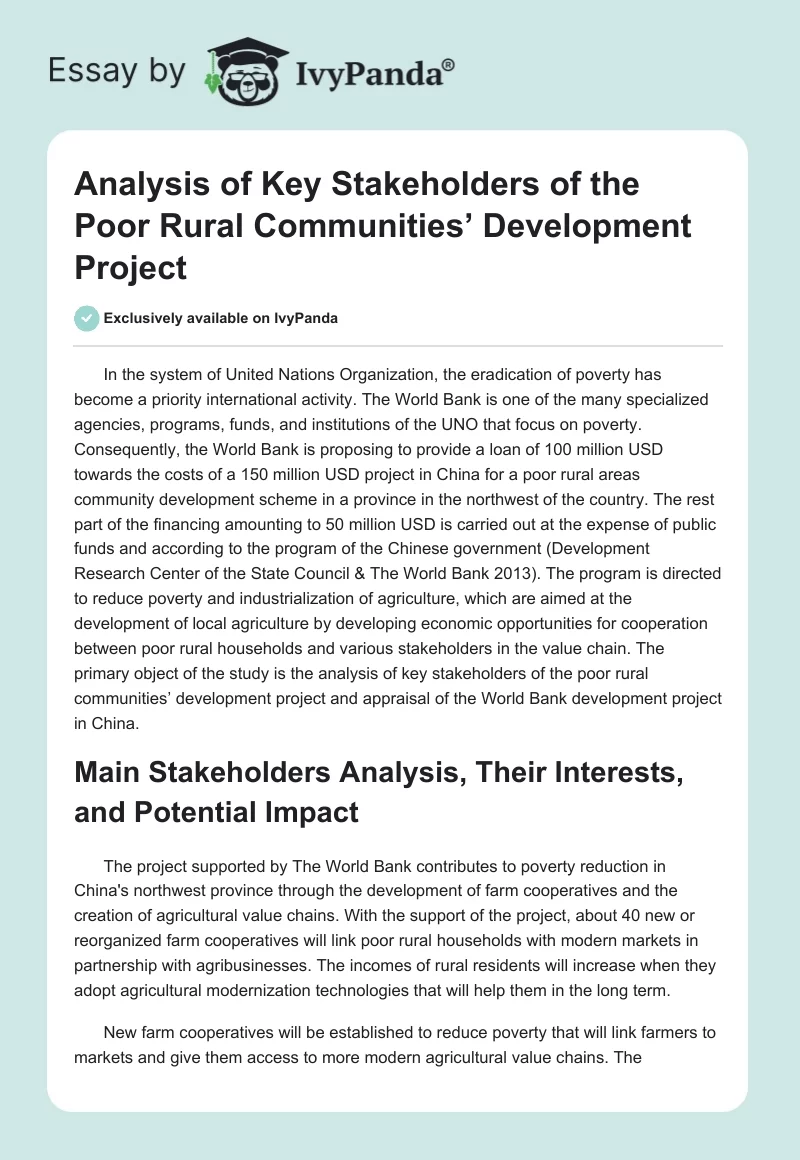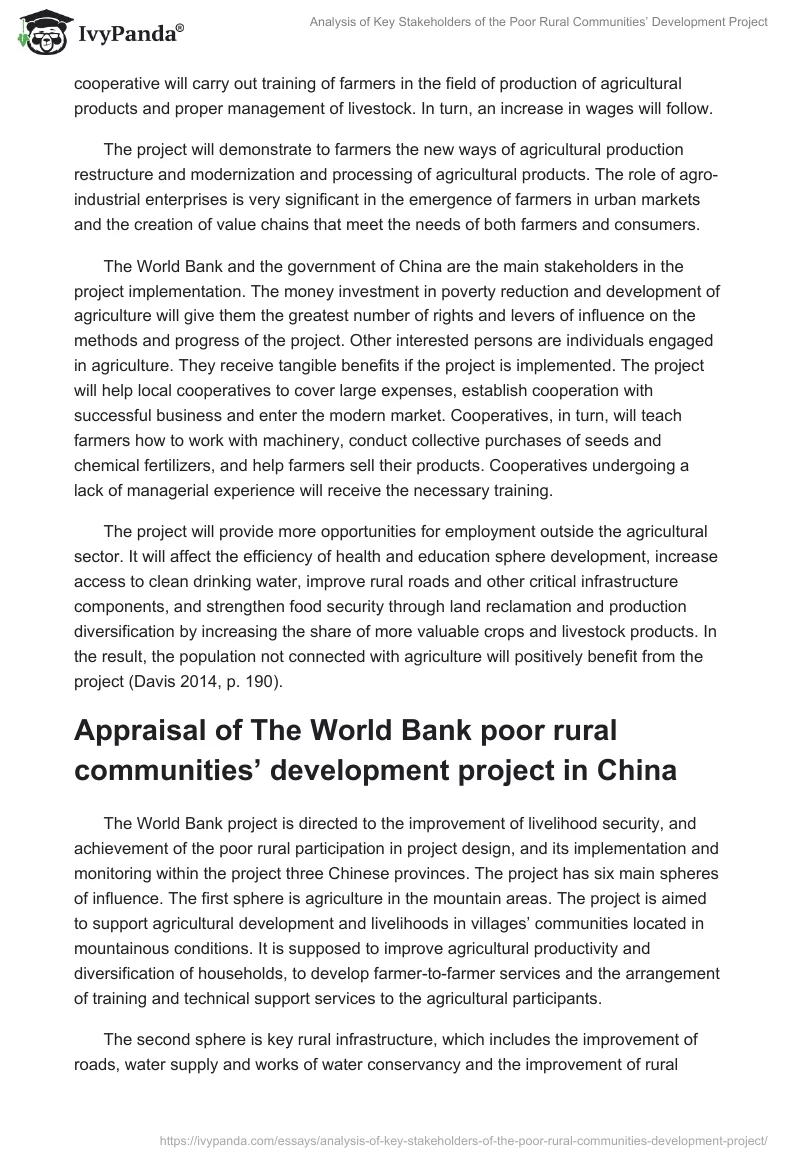In the system of United Nations Organization, the eradication of poverty has become a priority international activity. The World Bank is one of the many specialized agencies, programs, funds, and institutions of the UNO that focus on poverty. Consequently, the World Bank is proposing to provide a loan of 100 million USD towards the costs of a 150 million USD project in China for a poor rural areas community development scheme in a province in the northwest of the country. The rest part of the financing amounting to 50 million USD is carried out at the expense of public funds and according to the program of the Chinese government (Development Research Center of the State Council & The World Bank 2013). The program is directed to reduce poverty and industrialization of agriculture, which are aimed at the development of local agriculture by developing economic opportunities for cooperation between poor rural households and various stakeholders in the value chain. The primary object of the study is the analysis of key stakeholders of the poor rural communities’ development project and appraisal of the World Bank development project in China.
Main Stakeholders Analysis, Their Interests, and Potential Impact
The project supported by The World Bank contributes to poverty reduction in China’s northwest province through the development of farm cooperatives and the creation of agricultural value chains. With the support of the project, about 40 new or reorganized farm cooperatives will link poor rural households with modern markets in partnership with agribusinesses. The incomes of rural residents will increase when they adopt agricultural modernization technologies that will help them in the long term.
New farm cooperatives will be established to reduce poverty that will link farmers to markets and give them access to more modern agricultural value chains. The cooperative will carry out training of farmers in the field of production of agricultural products and proper management of livestock. In turn, an increase in wages will follow.
The project will demonstrate to farmers the new ways of agricultural production restructure and modernization and processing of agricultural products. The role of agro-industrial enterprises is very significant in the emergence of farmers in urban markets and the creation of value chains that meet the needs of both farmers and consumers.
The World Bank and the government of China are the main stakeholders in the project implementation. The money investment in poverty reduction and development of agriculture will give them the greatest number of rights and levers of influence on the methods and progress of the project. Other interested persons are individuals engaged in agriculture. They receive tangible benefits if the project is implemented. The project will help local cooperatives to cover large expenses, establish cooperation with successful business and enter the modern market. Cooperatives, in turn, will teach farmers how to work with machinery, conduct collective purchases of seeds and chemical fertilizers, and help farmers sell their products. Cooperatives undergoing a lack of managerial experience will receive the necessary training.
The project will provide more opportunities for employment outside the agricultural sector. It will affect the efficiency of health and education sphere development, increase access to clean drinking water, improve rural roads and other critical infrastructure components, and strengthen food security through land reclamation and production diversification by increasing the share of more valuable crops and livestock products. In the result, the population not connected with agriculture will positively benefit from the project (Davis 2014, p. 190).
Appraisal of The World Bank poor rural communities’ development project in China
The World Bank project is directed to the improvement of livelihood security, and achievement of the poor rural participation in project design, and its implementation and monitoring within the project three Chinese provinces. The project has six main spheres of influence. The first sphere is agriculture in the mountain areas. The project is aimed to support agricultural development and livelihoods in villages’ communities located in mountainous conditions. It is supposed to improve agricultural productivity and diversification of households, to develop farmer-to-farmer services and the arrangement of training and technical support services to the agricultural participants.
The second sphere is key rural infrastructure, which includes the improvement of roads, water supply and works of water conservancy and the improvement of rural networks of electrification and communications. Those actions would help to solve energy and sanitation problems of the region. The third sphere is education oriented. The project is aimed to solve the problem of poor and assailable children limited access to education and the incapability of the present education to improve the adult teaching and training level in rural communities for their future development. The fourth is health. The project will lead the financial assistance of medical care oriented on poor people. It presupposes free immunization and maternal care, and improvement of medical care workers training. The fifth point is connected with the improvement of the community productivity mainly oriented on management development. The project suggests the improvement of farm households’ skills and production, strengthen the administrative and financial management. The last sphere is connected with the management and monitoring of the project implementation.
Analyzing the World Bank project, it is necessary to pay attention to the cost-benefit appraisal that would best suit the various constituent parts of the project. First of all, it is necessary to exercise possible project benefits qualitative understanding. The project is aimed to achieve a number of economic and social benefits in China. Among the benefits are a per capita income increase and food security improvement at the expense of productivity increase of agricultural; an improvement of living standards due to extensive markets access possibilities, a solution of existing problems with transportation, water, and electric power infrastructures.
Another project benefits are the appearance of risks management ability due to education, health, and other social services improvement; land and natural resources development, and environmental destruction recovery; achievement of a strong cohesion of community and social groups’ status improvement, for instance, disabled people and women by gender equality establishment. Some of the named benefits can be quantified, but not all of them. For instance, the existing methods are developed for quantification of the benefits out of productivity improvement of agricultural, education sphere, and regional infrastructure. It is hard to quantify benefits in the social sphere, like gender equality, a strong cohesion of community and others.
For the analysis, the future stream of costs and benefits should be estimated at first and then for the net present value (NPV) and an economic rate of return (ERR) calculation to obtain net benefits (Nas 2016). The project benefits taken for the analysis are agriculture, infrastructure and education improvement. The amount of the investments to these spheres makes more than 85% of the whole project investment. To calculate the project ERR the individual ERRs proportion should be determined.
For the calculation, the following indicators were considered: an increase in per capita income by 5% annually, a period of expected return of the project for 35 years, and a discount factor of 0.1. The project expected return makes 30% as a whole, in particular, agriculture improvement accounts 35%, infrastructure development accounts 27%, and educational development makes 19%. The analysis makes it possible to consider the analyzed project effective and requiring implementation. However, it is advisable to carry out quarterly monitoring and the degree of implementation of the project and compliance with the expected indicators of its effectiveness with a view to timely responding and adjusting the subsequent actions aimed at achieving the set goals (The World Bank 2017).
Conclusion
In the conclusion of the study of the World Bank poor rural communities’ development project in China, it is clear that the economic and social viability of the project is entirely justified. All the observed stakeholders of the project would benefit in case of its implementation. The World Bank would make another successful step towards eradication of poverty in the world. China would solve vital problems of the country, namely poverty reduction and development of education, agriculture, infrastructure and others.
Tabular Presentation for the Stakeholder Analysis
Reference
Davis, K 2014, ‘Different stakeholder groups and their perceptions of project success’, International Journal of Project Management, vol.32, no. 2, pp. 189-201.
Development Research Center of the State Council, & The World Bank, 2013, China 2030: Building a Modern, Harmonious, and Creative Society, World Bank Publications.
Nas, T 2016, Cost-benefit analysis: Theory and application, Lexington Books.
The World Bank, China – poor rural communities development project, 2017. Web.


